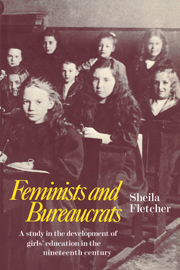Book contents
- Frontmatter
- Contents
- Preface
- Introduction: The Endowed Schools Act
- 1 The shaping of Section 12
- 2 The men who rejected the dead hand
- 3 The money problem
- 4 Opponents
- 5 Supporters
- 6 What was achieved
- 7 The changeover of 1874
- 8 The long haul
- 9 The Charity Commission spirit
- 10 The women's movement in the later years
- Appendices
- Notes
- Select Bibliography
- Index
10 - The women's movement in the later years
Published online by Cambridge University Press: 07 October 2011
- Frontmatter
- Contents
- Preface
- Introduction: The Endowed Schools Act
- 1 The shaping of Section 12
- 2 The men who rejected the dead hand
- 3 The money problem
- 4 Opponents
- 5 Supporters
- 6 What was achieved
- 7 The changeover of 1874
- 8 The long haul
- 9 The Charity Commission spirit
- 10 The women's movement in the later years
- Appendices
- Notes
- Select Bibliography
- Index
Summary
These schools…carried forward the work of the original pioneers and made the education of girls a reality. After the first, it was not at all an exciting movement; the slow beating down of ancient prejudice, the perpetual struggle with recurring difficulties, and the gradual widening out of a new idea is a process not capable of dramatic development.
Ray Strachey, The Cause, 1928That the point had come where the girls' cause was championed not by an Anne Glough or Maria Grey but by an elected local authority was a milestone, surely, a sound barrier broken, hinting at fulfilment of the feminist aim that secondary education for girls should be part of normal provision in the land. ‘The existence of girls had, as it were, been discovered.’ This comment made by the historian of ‘the cause’ on the educational scene of 1870 is just as relevant to 1900, particularly if we discard the idea that the battles waged on behalf of girls had been more or less won at the earlier date and that all that remained in the next three decades was ‘the necessary but undramatic task of expansion’. Naturally, what Mrs Strachey had in mind was the achievements of the pioneers: Miss Buss in Camden, Miss Beale at Cheltenham; Emily Davies founding Girton and her earlier masterstrokes – getting girls admitted to the Cambridge Locals and getting them considered by the Taunton Commission. Here, we are told, was the thin end of the wedge, and though opposition and hardship lay ahead, the thicker end was bound to follow.
- Type
- Chapter
- Information
- Feminists and BureaucratsA Study in the Development of Girls' Education in the Nineteenth Century, pp. 171 - 191Publisher: Cambridge University PressPrint publication year: 1980



